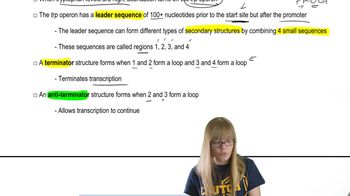Attenuation of trp operon transcription is controlled by the formation of stem-loop structures in mRNA. The attenuation function can be disrupted by mutations that alter the sequence of repeat DNA regions 1 to 4 and prevent the formation of mRNA stem loops. Describe the likely effects on attenuation of each of the following mutations under the conditions specified.
Table of contents
- 1. Introduction to Genetics51m
- 2. Mendel's Laws of Inheritance3h 37m
- 3. Extensions to Mendelian Inheritance2h 41m
- 4. Genetic Mapping and Linkage2h 28m
- 5. Genetics of Bacteria and Viruses1h 21m
- 6. Chromosomal Variation1h 48m
- 7. DNA and Chromosome Structure56m
- 8. DNA Replication1h 10m
- 9. Mitosis and Meiosis1h 34m
- 10. Transcription1h 0m
- 11. Translation58m
- 12. Gene Regulation in Prokaryotes1h 19m
- 13. Gene Regulation in Eukaryotes44m
- 14. Genetic Control of Development44m
- 15. Genomes and Genomics1h 50m
- 16. Transposable Elements47m
- 17. Mutation, Repair, and Recombination1h 6m
- 18. Molecular Genetic Tools19m
- 19. Cancer Genetics29m
- 20. Quantitative Genetics1h 26m
- 21. Population Genetics50m
- 22. Evolutionary Genetics29m
12. Gene Regulation in Prokaryotes
Tryptophan Operon and Attenuation
Problem 25b
Textbook Question
What is the likely effect of each of the following mutations of the trpL region on attenuation control of trp operon gene transcription? Explain your reasoning.
Region 4 is deleted.
 Verified step by step guidance
Verified step by step guidance1
Understand the role of the trpL region in attenuation control: The trpL region is part of the leader sequence of the trp operon and contains four regions (1, 2, 3, and 4) that can form stem-loop structures in the mRNA. These structures influence whether transcription continues or terminates based on tryptophan levels.
Recognize the function of Region 4: Region 4 is critical for forming the terminator stem-loop structure (between Regions 3 and 4). This structure causes RNA polymerase to terminate transcription when tryptophan levels are high.
Analyze the effect of deleting Region 4: Without Region 4, the terminator stem-loop cannot form. This means attenuation control is disrupted, and transcription of the trp operon genes will likely continue regardless of tryptophan levels.
Consider the physiological implications: If transcription is not terminated, the trp operon genes will be expressed even when tryptophan is abundant, leading to unnecessary synthesis of tryptophan and inefficient use of cellular resources.
Summarize the reasoning: The deletion of Region 4 removes the ability to form the terminator stem-loop, effectively disabling attenuation control and causing constitutive expression of the trp operon genes.
 Verified video answer for a similar problem:
Verified video answer for a similar problem:This video solution was recommended by our tutors as helpful for the problem above
Video duration:
8mPlay a video:
Was this helpful?
Key Concepts
Here are the essential concepts you must grasp in order to answer the question correctly.
Attenuation in Gene Regulation
Attenuation is a regulatory mechanism in prokaryotes, particularly in the trp operon, that controls gene expression based on the availability of tryptophan. It involves the formation of specific RNA structures during transcription that can either promote or inhibit the continuation of transcription depending on the cellular conditions.
Recommended video:
Guided course

Trp Attenuation
trp Operon Structure
The trp operon is a cluster of genes in bacteria that encode enzymes for tryptophan biosynthesis. It includes regulatory regions such as the leader sequence (trpL) that contains sequences capable of forming alternative secondary structures, which play a crucial role in the attenuation process by determining whether transcription will proceed or terminate.
Recommended video:
Guided course

Trp Attenuation
Role of Region 4 in Attenuation
Region 4 of the trpL sequence is essential for the formation of a transcription terminator structure. If Region 4 is deleted, the ability of the RNA to form this terminator is compromised, which can lead to increased transcription of the trp operon genes, as the attenuation mechanism is disrupted, allowing for continued expression even in high tryptophan conditions.
Recommended video:
Guided course

Trp Attenuation
Related Videos
Related Practice
Textbook Question
1023
views


